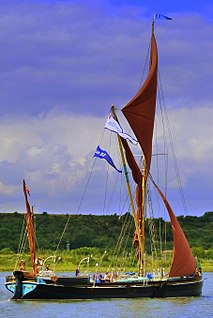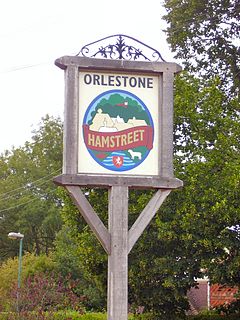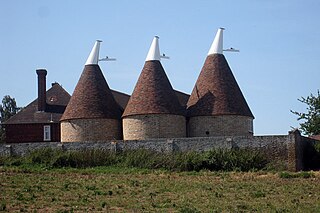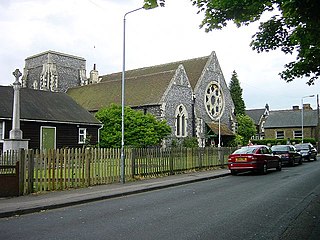
Swale is a local government district with borough status in Kent, England and is bounded by Medway to the west, Canterbury to the east, Ashford to the south and Maidstone to the south west. Its council is based in Sittingbourne. The district is named after the narrow channel called The Swale, that separates the mainland of Kent from the Isle of Sheppey, and which occupies the central part of the district.

Sittingbourne is an industrial town in Kent, south-east England, 17 miles (27 km) from Canterbury and 45 miles (72 km) from London, beside the Roman Watling Street, an ancient British trackway used by the Romans and the Anglo-Saxons and next to the Swale, a strip of sea separating mainland Kent from the Isle of Sheppey. The town became prominent after the death of Thomas Becket in 1170, since it provided a convenient resting point on the road from London to Canterbury and Dover.

A Thames sailing barge is a type of commercial sailing boat once common on the River Thames in London. The flat-bottomed barges with a shallow draught and leeboards, were perfectly adapted to the Thames Estuary, with its shallow waters and narrow tributary rivers. The larger barges were seaworthy vessels, and were the largest sailing vessel to be handled by just two men. The average size was about 120 tons and they carried 4,200 square feet (390 m2) of canvas sail in six working sails. The mainsail was loose-footed and set up with a sprit, and was brailed to the mast when not needed. It is sheeted to a horse, as is the foresail; they require no attention when tacking. The foresail is often held back by the mate to help the vessel come about more swiftly.

Teynham railway station is on the Chatham Main Line in England, serving the village of Teynham, Kent. It is 47 miles 74 chains (77.1 km) down the line from London Victoria and is situated between Sittingbourne and Faversham.

Faversham and Mid Kent is a constituency represented in the House of Commons of the UK Parliament. Since 2015, the seat has been represented by Helen Whately of the Conservative Party.

Sittingbourne and Sheppey is a constituency represented in the House of Commons since 2010 by Gordon Henderson, a Conservative.

Hamstreet is a village in Kent, in South East England.

The Saxon Shore Way is a long-distance footpath in England. It starts at Gravesend, Kent, and traces the coast of South-East England as it was in Roman times as far as Hastings, East Sussex, 163 miles (262 km) in total. This means that around Romney Marsh the route runs significantly inland from the modern coastline.

Lynsted is a village in Lynsted with Kingsdown civil parish in the Swale borough of Kent, England. The village is situated south of the A2 road between Faversham and Sittingbourne and the nearest M2 junction is Faversham three miles east. Lynsted is in many respects an archetypal old English village with church, churchyard with an ancient yew, pub and a duck pond. The village is locally referred to as Lovely, Lovely Lynsted and various songs have been written about it.

Lower Halstow is a village and civil parish in the Swale district of Kent, England. The village is northwest of Sittingbourne on the banks of the Medway Estuary. It lies north of Newington on the A2 Roman road.

Teynham is a large village and civil parish in the borough of Swale in Kent, England. The parish lies between the towns of Sittingbourne and Faversham, immediately north of the A2 road, and includes the hamlet of Conyer on an inlet of the Swale, the channel that separates mainland Kent from the Isle of Sheppey. Other hamlets include Deerton Street, Frognal, and Teynham Street. Teynham also has a carnival court. There is selections every year when girls from 14-18 can audition to be Miss Teynham or a Teynham princess.

Newington is a village and civil parish in the borough of Swale in Kent, England. The parish is located beside the A2 road between Rainham to the west and Sittingbourne to the east. The population of the parish in 2011 was 2,551.

Faversham was a parliamentary constituency centred on the town of Faversham in Kent which returned one Member of Parliament (MP) to the House of Commons of the Parliament of the United Kingdom.

Milton Regis is a village in the district of Swale in Kent, England. Former names include Milton-next-Sittingbourne, Milton Royal, Middleton, Midletun and Middletune. It has a population of about 5,000. Today it is a suburb of Sittingbourne, although this has not always been the case, with Milton Regis having an older and richer history. Until around 1800, Sittingbourne was a smaller hamlet and under the control of the Manor of Milton Regis.

South Swale is a 410.5-hectare (1,014-acre) Local Nature Reserve north of Faversham in Kent. It is owned by Kent County Council and managed by Kent Wildlife Trust. It is part of The Swale Ramsar site, Special Protection Area and Site of Special Scientific Interest

Murston is a suburb of Sittingbourne in Kent, England. It is about 1 mile north-east of central Sittingbourne, on the east bank of the Milton Creek.
Kemsley is a suburb of Sittingbourne in Kent, England.
Charles Richardson was the founder of the family Brick and Cement Firm A & WT Richardson Ltd, which lasted over 100 years. On 18 October 1840 he married Selina Ellis at Lambeth. The couple had one daughter, Selina Richardson born March 1842 and four sons - Alexander R Richardson born 1847, Walter T Richardson born 1849, Frederick Charles Richardson born 1851 and George Canning Richardson born March 1855.

Milton Creek Country Park is situated in 128 acres between Milton Regis and Kemsley, on the west bank of Milton Creek in Sittingbourne, Kent, England. This site was once called Church Marshes Country Park.

Ironsides is an iron-hulled Thames barge which was built in 1900 for APCM. She was registered in London. A 60 hp auxiliary engine was fitted in 1939.




















